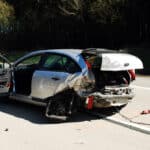
Traffic crashes and vehicle-related incidents are often a leading cause of police officer injuries and fatalities in the US. These work-related injuries can involve single or multiple vehicle collisions, or even occur when police are on foot and accidentally struck by vehicles on the road.
Here’s what you need to know about the common causes of officer-involved collisions and crashes.
Police Officer Vehicle Collisions & Crashes: What We Know
Whether officers are pursuing a vehicle or responding to a crash scene, they’re at risk for physical injuries and death.
The National Institute for Occupational Safety and Health (NIOSH) published a report identifying motor vehicle injuries as one of the top risks endangering public workers.
They found that motor vehicle crashes pose the highest risk of workplace fatalities in the US. Out of all public safety workers, police officers suffered the most fatalities due to traffic-related injuries sustained in motor vehicle crashes.
According to the latest data from the National Law Enforcement Officers Memorial Fund, 311 law enforcement officers were killed between 2011 and 2020 due to motor vehicle crashes. And according to the National Highway Traffic Safety Administration’s first quarter report for 2022, 21 officers were killed in traffic-related accidents, a 17% increase over the first quarter of 2021.
Common Causes of Officer-Involved Vehicle Collisions & Crashes
Being Struck in Traffic
The NHTSA’s first quarter report for 2022 found that 22% of crashes involved an officer being struck by a vehicle. For example, two troopers were struck and killed when trying to help an individual walking along the interstate. Others were involved in fatal accidents when removing debris and during suspect detainment.
Responding to Emergencies
According to the National Institute for Occupational Safety and Health, a key hazard that puts law enforcement officers at risk is speeding, particularly at intersections, due to emergency response.
Driving Distracted
Another hazard mentioned by the NIOSH is driving distracted. For example, officers must use in-car electronics to monitor emergenc es. They also must take calls and listen for updates via radio. In some cases, they must do all of the above while speeding to respond to an emergency.
An Added Danger: Seatbelt Usage
While the use of a seatbelt doesn’t cause a crash, it’s still a serious hazard for law enforcement, according to NIOSH. For the sake of responding to emergencies quickly, some officers forgo their seatbelts. Unfortunately, this can lead to serious injury or even death in the event of a crash.
Get Help from Attorneys With Experience Representing Law Enforcement
If you’ve been injured on the job as a police officer, you are eligible for worker’s compensation benefits and may have the right to pursue other claims. One form of coverage essential to police officers is underinsured/uninsured motorist coverage for the vehicles they own. When you are injured in a work-related crash, you need a legal team to help you with all the aspects of the claim or claims you may have.
Our attorneys at Keating Wagner Polidori Free have spent over 45 years helping injured police officers get the benefits they deserve. Contact us today at 303-534-0401 or send us a message to arrange a free and confidential consultation.









